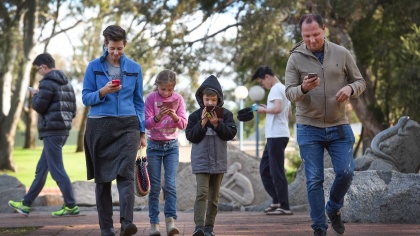
Lie: Virtual church services are an acceptable substitute for in-person church services.
Truth: Meeting in person is infinitely superior to ‘meeting virtually’ and should not be indefinitely curtailed.
Here in March 2021 in America, most churches are still either shut down entirely, or, if they are meeting in person, meet with a reduced capacity, or meet virtually or by virtue of a livestream broadcast, or a combination thereof. Very few have reopened to pre-pandemic occupancy; most continue to follow their state or local government’s emergency health orders.
After an entire year, why do churches continue to follow these health orders?
Simply put, it’s faith — but not faith in God. Rather, it’s faith in the institutions of government, media and medicine. It’s faith because these institutions speak their words, but there is little, if any, visible evidence that a pandemic is afoot. No one sees widespread death and disease. Yes, some have gotten sick or gotten tested and been told that they have COVID-19. But to most people, if they’re honest, it’s just another flu season.
Most church leaders are also going along with it and are not questioning; they’re not allowing themselves or others to question these things. But they should. It’s clearly not acceptable to question these things in most churches. But if it can’t be done wisely, carefully, and compassionately in church, then where else can it be done?
They continue to have strong faith in these institutions of government, media and medicine; and consequently, their faith in God and in the Lord of the Church has been weakened. And one of the biggest rationalizations for continuing to observe these restrictions on church meetings is that the church can now ‘meet virtually’ either through Zoom or Skype or some other video conferencing service. Or the megachurches that can live stream their services, offer their congregants the worship service in the comfort of their own home.
I believe this is a big lie that the church has swallowed whole. But it’s not just the lie of the pandemic; it’s one of the biggest lies that allows churches and church leaders to refuse to recognize the lie of the pandemic —
Here’s the lie:
Virtual church services are, under the current emergency, necessary, sufficient and acceptable to in-person church services.
The irony is that we all know that virtual meetings are nowhere near the edification, the meaning, the bodily experience of meeting in person. We know this. No one will argue that the two are equivalent or even nearly equivalent. But, since this is a commonly understood and yet apparently unsolved problem, we do not bring it up. We don’t know how. In effect, it becomes taboo. No one can solve the problem so no one says or does anything about this BIG GAP — the gap of virtual versus in person.

We shove this apparently unsolvable problem to the back burner and continue to go to our ‘virtual meetings,’ ‘kicking the can’ down the road and hoping that, one day, maybe once we have the vaccine, or have reached ‘herd immunity,’ we can go back to normal.
This problem, this gap, this grievous sin, is weakening and tearing the church apart, and we must not let it go on.
We falsely meet virtually ‘in order to love our neighbor’
The point I heard most often, made early on:
Because of the pandemic, we are refraining from meeting in person (to ensure social distancing, etc), so that we can love our neighbor well.
And yes, early on in March 2020, no one knew for sure what was happening, and so for a limited time, most thought it would be prudent to take this precaution, at least until we could get more information and chart a more solid direction. It was ‘15 days to flatten the curve’ remember? Okay, sure. We can refrain from meeting in person for that long.
But as we all know, the lockdowns, the restrictions, the government orders have continued, even a year later. We ‘let the camel get his nose under the tent’; we ‘gave an inch and now they’re taking a mile.’
But back to the assumption. For many, ‘going to church’ in our pajamas, virtually meeting, became a convenient habit. Consequently, discipline waned, we got weaker; stresses rose; we watched too much TV news; fear kept us apart; isolation and lockdown fatigue set in. And by the time churches opened to twenty-five to fifty percent capacity, we discovered that we no longer were sure we needed to ‘go to church on Sunday.’ The virtual church service, sanctioned by the church and government authorities, was much easier to ‘attend.’
But of course everyone knows very well, that ‘attending’ a virtual service is not really attending at all. There is no greeting one another with a holy kiss (or hug or handshake), no real conversation or encouragement, no baptism, no communion, no congregational singing — all things we’re commanded to do as a church body, all things that make up a true meeting of the saints.
As long as a virtual service is offered, it legitimates and sanctions it, makes it an acceptable substitute. But that’s the point: it’s NOT an acceptable substitute. As impressive as virtual meetings are, they can never substitute for the real thing. How could they?
But you say: Isn’t meeting virtually better than nothing?
Yes and no.
Yes: The Word of God is heard and people are encouraged.
No: People are deprived of human contact of a social, communal experience, that perpetuates the feeling of isolation and anxiety. But there are other more hidden adverse effects of dependence on virtual services. Below I will describe eight negative effects.
I will use the word condition in the following way: over time and with repeated use and when apparently no alternative is available, we will gradually become accustomed, and even begin to prefer, the ‘new normal.’ This happens slowly and imperceptibly, but it does happen and, if we passively accept this new normal, it will be nearly impossible to resist its conditioning power.
I also will use the phrase ignore the reality. What I mean by this is we often are willfully ignorant of things over which we have little control, and are unpleasant to ponder. Such is the case with virtual services.
Here are seven reasons that show indefinitely offering virtual church services is a bad idea.
An indefinite reliance on these services is a bad idea because:
1 Watching virtual church services conditions us to devalue location and place
The Bible teaches that the church is both universal and local, but the emphasis is clearly on the local. Paul wrote to the churches as local bodies — the church of Ephesus, of Rome, of Corinth, the churches of Galatia (a region, not a city) etc. The church is therefore essentially local. Why? It almost goes without saying but we otherwise may miss the profundity: the church is essentially local because, in order to meet on a regular basis, saints must live within a reasonable, travelable distance: thus the need for the church to be local. The meeting of the saints is paramount and this cannot happen without a localized number of saints.
But with the advent of Zoom, Webex, etc — video conferencing services — this fundamental truth breaks down. Now, saints no longer need to be localized; they can be practically anywhere in the world, as long as they have a digital device and a reliable internet connection. Location now is therefore not as important. We could always ‘meet online’ in a pinch, that is, if we get up too late or the weather is bad, or if we feel ill or if we simply don’t want to get dressed and put on makeup. Of course, other forces have devalued location; namely, modern transportation and electronic communication in general. But streaming video is another long nail in the coffin of local value.
2 Watching virtual church services conditions us to become spectators
It’s true that much of the evangelical church has become a passive, spectating experience. This is especially true in many megachurches that literally put on spectacles, complete with professional performers, sound, lighting, visuals, etc.[1] And sometime around 2005 –2010 many megachurches started live streaming and promoting their online services.
But then COVID hit and many smaller churches had to scramble to learn how to produce either a prerecorded service and/or a live-streamed service. Yet many churches simply were too small and did not have the expertise or the money to make this change. Those who followed the COVID rules were simply out of options for meeting — they could not meet in person or virtually, except through free services such as Zoom.

Many churches assumed that the lockdowns and restrictions were going to be temporary. Few imagined they would have lasted this long and still with no end in sight. So the switch to virtual was in some ways understandable, but it’s now gone on so long that many saints will never go back to in-person services. And no doubt, this is due to several reasons, but one major reason is that we have become accustomed to watching church.
3 Watching virtual church services legitimates and sanctions the virtual as a good enough, acceptable substitute for in-person services
The saints excuse/rationalize staying home and ‘watching church’ primarily because church pastors and leaders continue to indefinitely offer virtual services to all, and with few explanations, restrictions or limits.[2]
The virtual church service is now a widely acceptable substitute, a mainstay. Why? I’m afraid that one major reason, though it may sound quite cynical, is nonetheless true – virtual services are a lucrative revenue stream (no pun intended). The use of virtual streaming services potentially reaches many more people. Your church suddenly goes from local to global. Cutting off or curtailing this digital ‘product’ would obviously hurt the church’s ability to provide outreach, support missions and in general, minister to people.
But the truth is that virtual, spectator services can never be equivalent to in-person, and therefore the quality of ministry to the saints and their edification necessarily suffers. So by virtual services, churches reach more people, but do so generally in shallower ways. And in the process they reduce the worship of God to a shallow thing.
Digital things[3] are actually representations of the real and therefore are and always will be cheap and inferior to the real thing. A church service in a sanctuary with real people is of infinite value; however, the digital representation of that church service on your digital device, necessarily reduces its value — it becomes a representation of the real thing so that it must have a reduced value. This should be obvious.
The problem is that, we have become so accustomed to the visual representation, that we can now more easily believe the visual representation is real and even start to prefer the digital image and equate the digital image with the real. The digital quality — picture quality and streaming quality — has become so good that, prolonged and indefinite exposure and acceptance of these digital images makes them so seductive and nearly impossible to resist as real or near-real. In a way, we are forced to believe in the ‘reality’ of the digital image because we otherwise could not benefit from it. We too easily forget that these images are not solid.

And of course the virtual service does not exist in a vacuum — TV, movies and gaming have gone a long way toward conditioning us to project ourselves into the story unfolding before us.
The effect of this is that, the continued use of virtual church services causes us to lose their priceless value when we begin to believe this reduced value is the normal, actual value of church services. Everything in the service is then devalued: the music, the singing, the pastor, the scriptures, the message, communion, etc.
The digital image appears solid, but is actually fragile and ephemeral. The fact that virtual services are so ephemeral and under our control — we turn it on and we can so easily turn it off — also makes it a disposable thing. Whatever value it may have, it no longer has a lasting value.
All this is unspoken, subliminal, but nonetheless effective and powerful.
4 Watching virtual church services dissociates — separates — our bodily participation and virtualizes self and others
The worship of God is fundamentally a whole-person, bodily event. It should engage our whole person: body, soul and spirit. I could quote many scriptures here, but these should suffice:
Oh, clap your hands, all you peoples! Shout to God with the voice of triumph! — Psalm 47:1
Oh come, let us worship and bow down; Let us kneel before the Lord our Maker. — Psalm 95:6
Lift up your hands in the sanctuary, and bless the Lord. — Psalm 134:2
Greet one another with a holy kiss. — 2 Corinthians 13:12
But what happens when we ‘enter’ a virtual, digitized service? Our body stays put and is occupied with the things near it; but our minds, our attention, is drawn into the service. We watch, we listen, and we may participate to a degree by singing, or reading responsively. And we may actually raise our hands, clap, do all the bodily acts that we would do if we were present in the service. But most of us would strain to do this. It seems awkward to participate alone in our living room. Why? Simply because we are not present bodily.
This is where we bring up the concept of dissociation. Here’s how Wikipedia describes it:
Dissociation, as a concept that has been developed over time, is any of a wide array of experiences, ranging from a mild emotional detachment from the immediate surroundings, to a more severe disconnection from physical and emotional experiences. The major characteristic of all dissociative phenomena involves a detachment from reality, rather than a loss of reality as in psychosis.[4]
Virtualization — specifically passively watching a virtual service — fosters this dissociative process. It contributes to and conditions us to accept the separation of what is happening around us and is bodily available, from what we are trying to be mindful of.

This amounts to a loosening or tearing, and a peeling away of the mind from the body. This dissociative process is obviously not particular to the virtual service, but is present in any virtualizing experience: TV, radio, video conferencing, etc. The use of virtual services only reinforces the dissociation process already well underway.
5 Continuing to watch virtual church services ignores the reality that they are a force of separation and isolation
This also should be obvious, but it’s now such a profound force in our world that it is well worth clearly stating it.
Because virtual services condition us to devalue location and place (see number one above), at the same time it also conditions us to accept the consequent reality of the place of others in relation to ourselves. In other words, by virtually seeing others, we can more easily ignore the physical distance that separates us. It amounts to a false reality that, over time, we accept or conditionally accept as real or a ‘real equivalent.’
Consequently what actually happens is that we are isolated and separated from the ones we love, from real handshakes, hugs, intimate conversation, eye contact, the echo of other voices in the room, etc. These losses are innumerable and the effects of their loss on our mental, emotional, and spiritual well being are great. Only God knows the true loss that we’ve all gone through with the wide-scale acceptance and adoption of virtual in general and virtual church services in particular.
6 Continuing to watch virtual church services ignores the reality that they blur real and fake, and what is true and what is false
Currently, a clear line separates the virtual and the real; the virtual usually only exists on a screen. But augmented reality (AR) technology is coming and is actually already here. The initial rollout of AR in 2016 was the game Pokémon Go where gamers walk about using their mobile GPS phones and devices to locate, capture, train, and battle virtual creatures, called Pokémon, which appear as if they are in the player’s real-world location.[5]

Virtual services — streaming and live streaming — hasten that world by combining the physical and the virtual in one package.
And even more concerning, this AR world blends the real and the fake, the true and the false. If and when IoT and the virtual world is fully populated and overlays the real, it will become difficult to distinguish what is real and what is true. Journalist Raul Diego recently wrote an article for MintPress News titled, The Bits and Bytes of The Great Reset: COVID-19 and the Scaling Up of Data-Capitalism. As far-fetched as it may now seem, the digital overlay is what the global powers are aiming for. Here is Diego:
Efforts are now underway to “translate” the real world into a digital counterfeit that can provide financial markets with the figures and statistics it needs to execute the contracts of the incipient human capital markets – an insidious new form of capital assembled from our genetic code and other kinds of data that will form the basis of a financialized wonderland, enforced by blockchain technology and constantly monitored and updated through the burgeoning biosecurity state.
So we become like small children who cannot distinguish the real from the fake and who then must rely on their overlords to tell them what is true. This has already begun with widespread censorship and cancel culture and big tech’s paternal assertion and insistence that we listen only to officially-recognized sources, treating us like children who cannot think for ourselves.
For me, all of this would be a dystopian world; but for others who become accustomed to the virtual and what it offers, it actually may be a fake utopia. Personally I want no part in such a world, nor do I want to contribute to its acceptance, its promotion or its construction.
In the end, this AR amounts to a virtual dispossession — pushing us into a virtual ‘space’ not of our choosing. It is forced ‘relocation.’ If there is no other world, that is, if the AR world fully encloses the natural, real world, we will have no ‘place’ to go.
Be vigilant for the invasion and co-opting of physical space by the virtual and how the physical and virtual worlds come together. Here are a few examples of this happening now[6]:
- use of QR codes or other tokens that allow you to gain access to something
- pharmaceutical patches read with smartphones
- Alexa smart speakers
- drones, robots, sexbots
- smart watches, Fitbit/wearables
7 Continuing to watch virtual church services fosters a dependence on them
In America, when COVID hit in March of 2020, most of the church went exclusively online. And, as I said earlier, the megachurches were already there, but the rest of the church had to scramble to quickly learn how to get there. And many, if not most church leaders, were thanking God that the technology was available to go online; otherwise, the sheep would apparently have scattered, at least that was the common view.
But what if COVID had happened ten years earlier, before video streaming services were widely available? What would churches have done when the governing authorities locked down the world? Would there have been more resistance to the lockdowns? Maybe not initially, but after a month, three months, six months, a year of apparently arbitrary restrictions?
I think so.
But as it is, most of the church remains compliant with government restrictions and lockdowns, primarily because of the virtual service, its ‘relief valve.’ And so consequently, the virtual service becomes commonplace, the new normal; we acquiesce and develop an unhealthy dependence on them. Unhealthy because of the reasons one through six above.
Conclusion
So how should we view virtual church services? Good, bad, indifferent, or a necessary evil?
Each church should carefully consider this question, and not just as a practical solution; not just as a means to reach more people or to offset the lockdowns and capacity limits. The question should be asked in light of its long-term effects on us as individuals and as local churches. And we must ask the question in light of the larger cultural forces that surround it.
If it can be done, at the very least, virtual services should be used only as secondary, supplemental and temporary, not as primary or indefinite/permanent vehicles. For example, one megachurch I know — even before COVID — announced that they were establishing a virtual ‘campus,’ complete with their own support services: elders, deacons, etc.
Finally, we must listen to our Living Head: the Lord Jesus Messiah. He must have the final word and no one else.
Jesus answered and said to him, “Blessed are you, Simon Bar-Jonah, for flesh and blood has not revealed this to you, but My Father who is in heaven. And I also say to you that you are Peter, and on this rock I will build My church, and the gates of Hades shall not prevail against it. — Matthew 16:17–18
[1] See also my article: LIE: Worship is an experience of God’s presence, part 1 and part 2.
[2] I’m not saying that offering virtual services with restrictions (recommending only once per month, or only to the sick or aged, etc) is acceptable; I’m only making the point that it’s not being done, at least by most pastors.
[3] To digitize is to ‘thingify.’ To digitize is to, first, atomize and then attempt to reconstruct the object – place, pastor, people – with digits so that it can be represented and processed by a computer. Digitization necessarily destroys the real thing, including living things, in order to recreate them so that they can then be controlled and manipulated as an independent, virtual ‘thing,’ usually on a computer screen.
[4] https://en.wikipedia.org/wiki/Dissociation_(psychology)
[5] https://en.wikipedia.org/wiki/Pokémon_Go
[6] See also my article: LIE: Passive use of the internet is harmless, part 3.